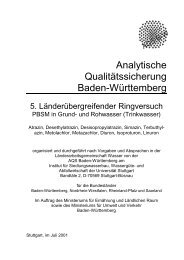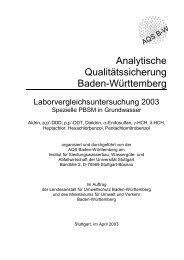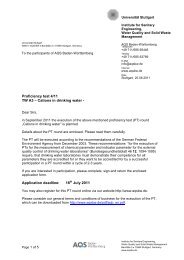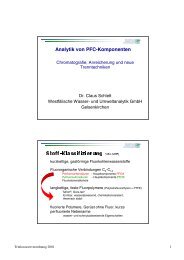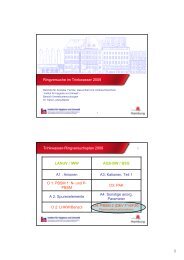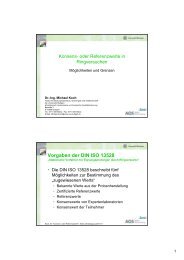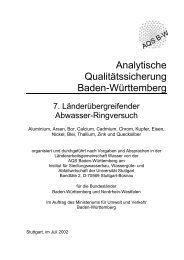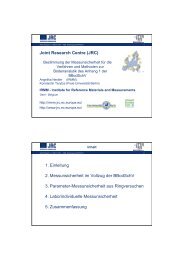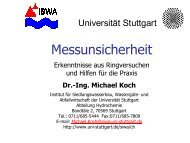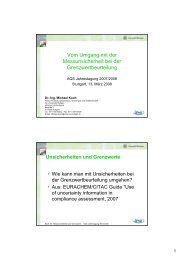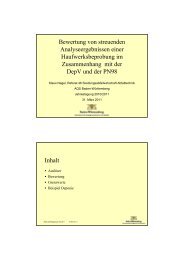Institute for Sanitary Engineering, Water Quality and Solid Waste ...
Institute for Sanitary Engineering, Water Quality and Solid Waste ...
Institute for Sanitary Engineering, Water Quality and Solid Waste ...
Create successful ePaper yourself
Turn your PDF publications into a flip-book with our unique Google optimized e-Paper software.
<strong>Solid</strong> <strong>Waste</strong> Management SIA<br />
Projects<br />
City with Energy Efficiency - SEE Stuttgart<br />
The project LAKE traced to the following objectives:<br />
1. Development of a macroscopic balance model<br />
2. Development of a microscopic model strategy<br />
3. Identification of optimization potential<br />
4. Creating a Road Map „energy“ by 2050<br />
5. Implementation of identified actions<br />
6. Evaluation of operations <strong>and</strong> per<strong>for</strong>mance review<br />
Prerequisite <strong>for</strong> a sustainable society is in addition to<br />
economic prosperity <strong>and</strong> social well-being also a healthy<br />
environment. It is necessary to reduce emissions<br />
of pollutants - in particular climate-relevant pollutants<br />
- <strong>and</strong> to increase significantly the efficiency of resources<br />
use. As undisputed the need <strong>for</strong> energy <strong>and</strong> resource<br />
efficiency in society <strong>and</strong> politics is, so difficult<br />
is the setting of concrete goals <strong>and</strong> the underst<strong>and</strong>ing<br />
on the „right“ strategies <strong>and</strong> actions. Reasons <strong>for</strong> this<br />
include the difficulties of assessing impact of measures<br />
in the framework of <strong>for</strong>mulation of policy / planning<br />
strategies (overall effectiveness, as well as the contribution<br />
of well targeted measures to achieve the objectives)<br />
<strong>and</strong> the uncertainty about the nature <strong>and</strong> scope<br />
of opportunity costs in the case of scope achievement<br />
as well as the potential distributional effects of social<br />
costs. A suitable tool <strong>for</strong> municipal planning strategy<br />
may be models that allow assessing the effects of<br />
various measures in terms of their individual as well as<br />
cumulative effect. In this framework, with the project<br />
SEE it is meant to develop a macro <strong>and</strong> a microscopic<br />
balance <strong>and</strong> strategy model to support the development<br />
of the local strategies <strong>and</strong> action planning.<br />
The project SEE has the following objectives:<br />
1. Development of a macroscopic balance model<br />
2. Development of a microscopic strategy model<br />
3. Identification of optimization potential<br />
4. Creating a Road Map „energy“ up to 2050<br />
5. Implementation of identified measures<br />
6. Evaluation of measures <strong>and</strong> per<strong>for</strong>mance review<br />
Key activities of the Chair of <strong>Solid</strong> <strong>Waste</strong> Management<br />
<strong>and</strong> Exhausted Air:<br />
• Macroscopic balance model <strong>for</strong> the energy<br />
consumption of consumer goods in Stuttgart<br />
• Microscopic balance <strong>and</strong> strategic model <strong>for</strong> energy<br />
consumption of households in Stuttgart caused<br />
by the consumption of goods<br />
• Development <strong>and</strong> evaluation of measures in the<br />
waste <strong>and</strong> consumption area<br />
Optimization<br />
potential<br />
Balance <strong>and</strong> strategy<br />
model<br />
Implementation<br />
Evaluation of<br />
of optimization<br />
per<strong>for</strong>mance<br />
measures<br />
Balance <strong>and</strong> strategy model<br />
Financing institution:<br />
Bundesministerium für Bildung und Forschung BMBF<br />
- Förderinitiative „Wettbewerb Energieeffiziente<br />
Stadt“<br />
Project partner:<br />
Regional Capital City of Stuttgart<br />
• EnBW Energie Baden-Württemberg AG<br />
• Fraunhofer-<strong>Institute</strong> <strong>for</strong> Construction Physics<br />
• University of Stuttgart<br />
<strong>Institute</strong> of Railway <strong>and</strong> Transport Sciences<br />
(IEV)<br />
<strong>Institute</strong> <strong>for</strong> Regional <strong>and</strong> Development Planning<br />
(IREUS)<br />
<strong>Institute</strong> <strong>for</strong> <strong>Sanitary</strong> <strong>Engineering</strong>, <strong>Water</strong> <strong>Quality</strong><br />
<strong>and</strong> <strong>Waste</strong> Management, Chair of <strong>Solid</strong> <strong>Waste</strong><br />
Management <strong>and</strong> Exhausted Air (ISWA, AFW)<br />
<strong>Institute</strong> of Social Sciences, International Center<br />
<strong>for</strong> Cultural <strong>and</strong> Technological Research (IZKT);<br />
Interdisciplinary Research Risk <strong>and</strong> Sustainable<br />
Technology Development (ZIRN)<br />
<strong>Institute</strong> of Road <strong>and</strong> Transportation, Department<br />
of Transport Planning <strong>and</strong> Traffic Control Systems<br />
(VUV)<br />
Duration:<br />
April 2009 - March 2010<br />
Contact:<br />
Prof. Dr.-Ing. Martin Kranert<br />
Dipl.-Ing., M.Sc. Mihaela Berechet<br />
Dipl.-Geol. Detlef Clauß<br />
75




